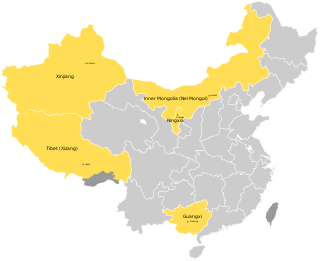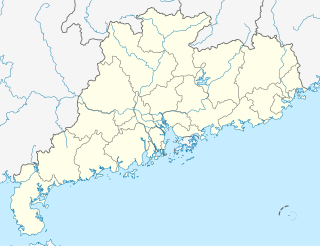
The demographics of China demonstrate a large population with a relatively small youth component, partially a result of China's one-child policy. China's population reached 1 billion in 1982.

The Tibet Autonomous Region (TAR) or Xizang Autonomous Region, often shortened to Tibet or Xizang, is a province-level autonomous region of the People's Republic of China in Southwest China. It was overlayed on the traditional Tibetan regions of Ü-Tsang and Kham.

Guizhou is a landlocked province in the southwest region of the People's Republic of China. Its capital and largest city is Guiyang, in the center of the province. Guizhou borders the autonomous region of Guangxi to the south, Yunnan to the west, Sichuan to the northwest, the municipality of Chongqing to the north, and Hunan to the east. The population of Guizhou stands at 38.5 million, ranking 18th among the provinces in China.

Chinese people are people or ethnic groups identified with China, usually through ethnicity, nationality, citizenship, or other affiliation.

An autonomous region is a first-level administrative division of China. Like Chinese provinces, an autonomous region has its own local government, but under Chinese law an autonomous region has more legislative rights, such as the right to "formulate self-government regulations and other separate regulations." An autonomous region is the highest level of minority autonomous entity in China, which has a comparably higher population of a particular minority ethnic group.

Tuva or Tyva, officially the Tyva Republic, is a federal subject of Russia.

The National Bureau of Statistics, abbreviated as NBS, is an deputy-cabinet level agency directly under the State Council of the People's Republic of China. It is responsible for collection, investigation, research and publication of statistics concerning the nation's economy, population and other aspects of the society. Ning Jizhe is the commissioner of the bureau since 2016.

Chancheng District is a district and the seat of the city of Foshan, Guangdong Province, China.

Huaiji County is a county of western Guangdong province, People's Republic of China. It is under the administration of Zhaoqing City.

Dinghu District is a district of Zhaoqing, Guangdong province, People's Republic of China.

Duanzhou District is a district of Zhaoqing, Guangdong province, People's Republic of China. Duanzhou is the urban center of Zhaoqing.

Huicheng District is a district of Huizhou City, Guangdong Province, China. Huicheng is the northern urban center of Huizhou along with Huiyang as the southern urban center.

Chengqu, or Cheng District is a district of Jincheng, Shanxi, China. As of 2010, it had a population of 470,000, an increase of 56.78% from 2000, living in an area of 141 km2 (54 sq mi).

The 2010 Chinese census, officially the Sixth National Population Census of the People's Republic of China, was conducted by the National Bureau of Statistics of the People's Republic of China with a zero hour of November 1, 2010.
The 1964 Chinese census, officially the Second National Population Census of the People's Republic of China, was conducted by the People's Republic of China with a zero hour of 1 July 1964. The results of the census were not publicized and its very existence was not officially acknowledged until the early 1980s.
The 2000 Chinese census, officially the Fifth National Population Census of the People's Republic of China, was conducted by the government of the People's Republic of China with 1 November 2000 as its zero hour. The total population was calculated as 1,295,330,000. The census also covered population growth, number of households, sex, age, ethnicity, educational attainment, and urban and rural population.